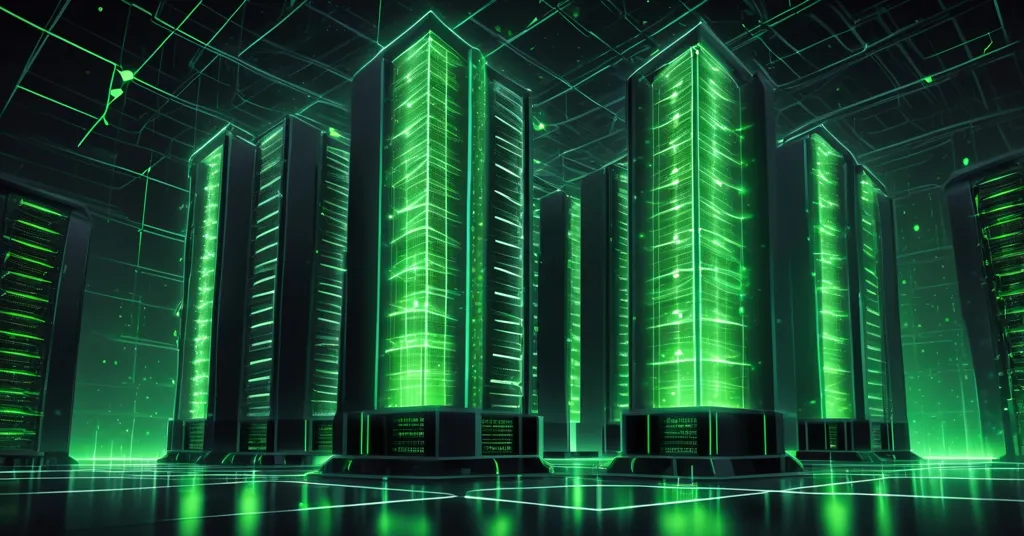Ripple CTO David Schwartz Launches Powerhouse Server to Boost XRP Ledger Stability

Ripple CTO David Schwartz Rolls Out Beastly Server to Power Up XRP Ledger—Here’s the Real Impact
Ripple’s Chief Technology Officer, David Schwartz, has gone rogue—in the best way possible—by personally deploying a high-performance server to supercharge the XRP Ledger (XRPL). This independent move, separate from his day job at Ripple, is a hardcore commitment to boosting network stability and decentralization at a time when XRPL is handling massive transaction volumes and eyeing bigger financial use cases. But is this a game-changer or just a shiny new toy for the network? Let’s break it down.
- Solo Mission: Schwartz launches a top-tier server for XRPL, entirely on his own dime, not Ripple’s.
- Network Muscle: Designed to support key nodes and validators with cutting-edge hardware for rock-solid connectivity.
- Decentralization Push: A direct jab at centralization critics, aiming to spread trust across the network.
The Server: A Technical Titan for XRPL
Schwartz, often known as “JoelKatz” in crypto circles, isn’t messing around with this project. The server he’s unleashed is a beast, built to handle serious workloads and keep XRPL humming under pressure. We’re talking an AMD 9950X CPU, 256GB of RAM, a 2TB boot SATA SSD, and dual 2TB NVMe SSDs set up in RAID 0 (a configuration that splits data across drives for blistering speed) to optimize NuDB performance—that’s the database XRPL uses to store its transaction history, for those new to the tech. On top of that, it’s got a 10GB unmetered internet link and runs on Ubuntu LTE, all hosted in a New York City data center. In plain English, this setup ensures lightning-fast data processing to prevent bottlenecks when transaction volumes spike, as detailed in recent technical reports on Schwartz’s server specs.
Right now, the server is synced with the XRPL network and undergoing stability tests, with weeks of hardening and battle-testing on the horizon to make sure it’s ready for the big leagues. Schwartz has been crystal clear: this isn’t a playground for experiments. It’s meant for production-level action, supporting real-world usage without disruptive testing unless it’s absolutely unavoidable. The goal? To act as a high-quality hub with reserved connection slots for critical components like UNL validators—think of them as trusted referees in the XRPL game, ensuring everyone agrees on transaction outcomes without a central boss—and other key nodes or applications built on the ledger. You can find more about this initiative’s focus in Schwartz’s own words on XRPL infrastructure.
But it’s not an exclusive club. Schwartz has opted for a hybrid access model, reserving slots for these VIP network players while still allowing public connections on a best-effort basis. This balance is a nod to XRPL’s core ethos of distributed trust, a principle Schwartz hammers home by insisting no one should rely on a single node for essential services. As he put it himself:
“I haven’t run any XRPL infrastructure myself in a few years. Looking at the network, it seems like the most useful thing would be a high-quality hub with reserved slots for UNL validators, other hubs, and servers serving applications on XRPL.”
Why Now? XRPL’s Growth Is Testing Its Limits
This hardware flex isn’t just for show—XRPL’s usage is skyrocketing, and its infrastructure needs to keep up. Recent figures are staggering: the network processed 70 million new transactions in the past month, bringing its total to 3.83 billion, with a daily average of 1.8 million transactions. That’s among the highest of any major blockchain, putting XRPL in a league of its own for raw throughput. It’s not just numbers on a chart, either. The ledger is carving out a serious niche as a global settlement layer for stablecoins and tokenized assets. Take Braza Bank, which issued $4.2 million in BBRL—a stablecoin pegged to the Brazilian Real—directly on XRPL. Or RLUSD, another stablecoin, whose daily transactions surged from 5,000 to over 12,000 in July alone.
For context, XRPL isn’t new to the game. Launched in 2012, it’s a decentralized blockchain built for speed and dirt-cheap transactions, often pitched as a go-to for cross-border payments and institutional finance. But with great power comes great scrutiny. Critics have long jabbed at XRPL for perceived centralization, pointing fingers at Ripple’s massive XRP holdings and influence over the ecosystem. Schwartz’s server drop feels like a direct counterpunch, showing that even the top brass are grinding to ensure the network stays autonomous and resilient. Historically, XRPL has faced stress points—think occasional node sync issues or latency under heavy load. While not catastrophic, these hiccups highlight why beefed-up hubs like this one are crucial as adoption ramps up, a point reinforced by recent updates on UNL validators’ role in network stability.
Schwartz’s Motive: A Personal Stake in XRPL’s Future
There’s something raw and refreshing about a CTO like Schwartz getting back to the nuts and bolts of infrastructure after years of high-level strategy at Ripple. This isn’t just a tech upgrade; it’s a personal mission. Schwartz, a co-creator of XRPL, has been vocal about his belief in the network’s potential to revolutionize finance. His decision to fund and deploy this server independently screams commitment to a distributed future for XRPL, separate from corporate agendas. He’s also doubling down on XRP’s value being tied to utility, not hype, stating that real-world financial applications—think instant global payments or tokenized securities—will be the true driver of the token’s worth over time, a perspective echoed in expert analysis of his projects and XRP’s utility.
Community reactions are starting to trickle in, and they’re a mixed bag. On platforms like XRPChat and Reddit, some enthusiasts are hailing this as a pivotal step toward network autonomy, with one user calling it “a middle finger to centralization FUD.” Others are more skeptical, questioning whether one server, even from a heavyweight like Schwartz, can shift the needle when Ripple’s shadow looms large. It’s a fair point—personal or not, Schwartz’s ties to Ripple inevitably color how this is perceived. Still, his hands-on approach could inspire other independent operators to step up, potentially sparking a wave of grassroots infrastructure support. Community discussions, such as those on Reddit about the server’s impact, reflect this divided sentiment.
Decentralization: Real Progress or Just Optics?
Let’s get real: this server is a solid move toward reinforcing XRPL’s distributed control. By prioritizing UNL validators and key nodes, it reduces the risk of bottlenecks or single points of failure—exactly the kind of thing centralization critics love to harp on. Schwartz’s explicit stance that “no one should depend on a single node for critical services” aligns perfectly with the spirit of blockchain as a trustless, peer-to-peer system. For a network often accused of being too cozy with Ripple’s corporate interests, this feels like a deliberate push to diversify power across more hands, though challenges remain as outlined in Ripple’s own strategy on decentralization hurdles.
But let’s play devil’s advocate for a second. One server, no matter how beefy, doesn’t magically erase XRPL’s broader perception issues. Ripple still holds a massive chunk of XRP, and their ongoing legal slugfest with the SEC over whether XRP is a security continues to spook potential institutional adopters, especially in the U.S. Sure, a stable infrastructure might reassure hesitant banks or fintechs, but regulatory uncertainty is a much heavier anchor. And while the hybrid access model sounds democratic, smaller node operators might get the short end of the stick if demand spikes and priority slots hog all the bandwidth. If anything, this could unintentionally centralize access among the “VIPs” Schwartz is catering to. It’s a prickly tradeoff that the community will need to wrestle with as XRPL scales, a concern also raised in discussions on Ripple’s influence over XRPL decentralization.
XRPL vs. Blockchain Titans: How Does It Stack Up?
Put XRPL’s daily transaction volume of 1.8 million up against the giants, and it’s clear this network is punching above its weight, especially for its niche focus on financial settlements. Bitcoin, the granddaddy of crypto, processes far fewer transactions daily—often under 500,000—due to its design as a store of value rather than a high-speed payment rail. Its scaling solutions, like the Lightning Network, aim to offload smaller transactions, but they’re still a work in progress. Ethereum, on the other hand, handles a comparable volume to XRPL but with heftier fees and a broader focus on smart contracts and DeFi. Layer 2 solutions like Optimism or Arbitrum are easing Ethereum’s congestion, but costs remain a barrier for mass adoption.
XRPL’s edge lies in its laser focus on speed and cost—transactions settle in seconds for fractions of a penny. Schwartz’s server could cement that advantage by ensuring uptime and reliability under heavy loads, something neither Bitcoin nor Ethereum can fully claim without their off-chain crutches. Yet, XRPL lacks the sprawling developer ecosystem of Ethereum or the cultural clout of Bitcoin as digital gold. Infrastructure upgrades are vital, but they’re not a silver bullet for broader mindshare or adoption. XRPL’s bet is on niche dominance in finance, and hubs like this one are a step toward making that bet pay off—provided they don’t choke under pressure or get tangled in centralized baggage, as noted in coverage of Schwartz’s impact on network decentralization.
Hurdles Ahead: Who Pays, and Who Plays?
Running a server with these specs isn’t pocket change. High-end hardware, data center hosting in NYC, and a 10GB internet link come with a hefty price tag, likely in the thousands per month at minimum. Schwartz footing the bill personally is admirable, but it begs a bigger question: who sustains this long-term? If XRPL needs a fleet of such hubs for true resilience, will community grants, Ripple’s deep pockets, or other independent players step up? The economics of decentralized infrastructure are a messy unsolved puzzle across all blockchains, not just XRPL.
Then there’s the regulatory elephant in the room. Ripple’s SEC battle has dragged on for years, casting a shadow over XRP’s market perception and slowing institutional uptake in key markets like the U.S. A tricked-out server might signal confidence to hesitant partners, but it can’t rewrite legal rulings. If anything, infrastructure stability could be a quiet selling point for non-U.S. entities—like Braza Bank—looking to leverage XRPL without wading into American red tape. Still, until the legal dust settles, adoption might remain a patchwork of regional wins rather than a global tidal wave.
Key Questions and Takeaways for the Crypto Crowd
- What’s the core purpose of David Schwartz’s XRPL server?
It’s a high-powered hub to boost network stability, offering dedicated slots for UNL validators and critical nodes to handle XRPL’s growing financial workloads. - Does this truly tackle XRPL’s centralization critiques?
Partially—it reduces reliance on single failure points, but Ripple’s influence and XRP holdings still fuel skepticism about full network autonomy. - How might smaller node operators be affected by this setup?
The hybrid model prioritizes key players, so smaller operators could face limited access during high demand, despite public slots being available. - Can infrastructure upgrades alone drive XRP’s long-term value?
Not solo—while stability supports adoption, XRP’s worth also depends on regulatory outcomes and wider acceptance of its financial use cases. - What’s the next step for XRPL’s scalability with this kind of boost?
If it proves reliable, this could encourage more independent hubs, further distributing control and prepping XRPL for heavier stablecoin and asset tokenization traffic. - Is XRPL’s infrastructure edge enough to outpace Bitcoin or Ethereum?
It’s a strong start—XRPL’s speed and cost shine, but it lacks the ecosystem depth of Ethereum or Bitcoin’s cultural weight. Stability is just one piece of the puzzle.
Schwartz’s server rollout is a gritty, geeked-out love letter to the XRP Ledger, proving that even as XRPL chases institutional glory, its roots in community-driven tech aren’t buried. Whether this sparks a domino effect of decentralized contributions or stands as a lone hardware flex, it’s a loud reminder that blockchain’s future hinges on systems that can bear the weight of a financial upheaval. If it also slaps a few centralization naysayers awake, well, that’s just a bonus. So, will one server ignite a broader push for network independence, or is XRPL still wrestling with deeper systemic chains?



